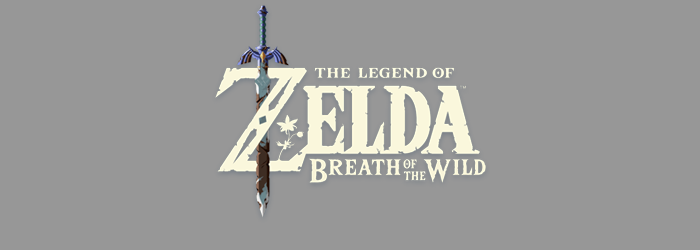More Information from Nintendo
- Genre: Action/Adventure
- Platform: Switch
- Also Available On: Wii U
I kind of expected this one to not live up to the hype, especially given the reviews it was getting up to release. However, for me it definitely nailed it. Even given the quality of past Zelda games, this is a tremendously special game.
As far as open world games go, there’s a certain set of expectations involved with what you’re going to see as a player. Most of them have some form of collecathon of things all around the world, a relatively loose structure in how you get between different quests, and more recently, some way to reveal portions of the map to the player as they explore. Breath of the Wild certainly sticks to some of these conventions, but in doing so they’ve also shaped the conventions in a way that make the game still feel distinctly Zelda.
Nintendo went all the way with the story being entirely open world. Once you finish the tutorial you’re given a couple quests as is typical of the genre. What isn’t typical is that one of them is literally to go kill Ganon. From this point forward, you can either explore and do things that will expand your repertoire, or you can literally go finish the game. More than any other open world game I’ve played, this very quickly establishes the expectation here. You can do whatever you want, whenever you want, and finish the game whenever you feel like it’s time to do so. Everything else that is typical of Zelda games falls into this setup. What also isn’t typical is that the tutorial gives you all of the items and skills you will earn within the game, upgrades not withstanding.
Despite some of the lead in news, dungeons are there, but you have to earn your way to them, and they can be done in any order. The dungeons themselves focus more on puzzles than combat, and tend to be somewhat shorter than past games. However, what they lack in length, they make up for in quality. The core theme here is puzzles tied to environment manipulation. Upon completion of the core puzzle, there is of course a boss fight, this time acting as proof of mastery of the skills earned at the start of the game. While not being a necessity anymore, the quality of the dungeons absolutely made them worth completing, if for no other reason than the story elements they provide showing the past of the world.
It’s also worth nothing that despite the reduction in dungeon count and size, the world itself provides more than enough to cover this missing element. Within the world you can find over 100 individual shrines to complete, as well as towers that provide the map viewing coverage typical of open world games. While these things do provide the way to fast travel, these are also the main puzzle element present in Breath of the Wild. Each tower tended to focus one on specific skill in manipulating the environment to get to the point where you could climb and complete the tower. On the other hand, each shrine effectively acts as a fantastic mini dungeon, with a huge variety in what is available. These ran the gamut of what was available in the game. Some of the shrines were just simple combat rooms. Some shrines had a focus on individual skills like manipulation of air for gliding, or the use of fire-based weapons to burn a path to the end. Still some of them were there purely for amusement, like one physics-based minigolf shrine. While completing the shrines did ultimately give rewards that resulted in heart and stamina upgrades, they also provided a nice way to break up the game as I traveled around the world of Hyrule.
Despite all the changes from the usual Zelda formula, the one that was most striking to me is how they changed the use of music in the game. Outside of towns, there is hardly any music, apart from some sporadic piano melodies. Even within towns, the music was typically fairly subdued, and the bulk of what could be called the soundtrack was composed of ambient noise from the abundant wildlife throughout the environment. When the music does kick in though, they definitely aren’t shy about bringing in some hints of the past whether it’s night or day. Overall while it’s not as in your face as is typical, this soundtrack is another memorable one in the books for this series.
What became quickly apparent playing this game was just how polished it was, and it’s always in the little details. There’s a ton of wildlife around, and it’s not just there for show. It can be hunted, and the supplies you earn from doing so can be cooked into food to heal Link in battle. Because you CAN climb anywhere, you end up climbing just for the sake of it. Because shrines are then typically glowing orange against the background, climbing anywhere typically gives you new goals on the horizon to go for, further providing you with new things to do. Large scale bow aiming with the analog stick is there, but subtle motion controls provide an extremely fast and precise way to accurately aim in small amounts for things far in the distance. Camps of enemies can be cleared in straightforward combat, but it’s also just as practical to roll a rock down a hill onto the group, send fire arrows into explosive barrels, or lead enemies into traps by chucking bombs into their midst. Those are all little separate things, but I hope it’s making my point here. The amount of polish in place is of a level that only a few other companies ever attempt to approach. This is on a level typical of companies like Naughty Dog or Rockstar, and I’d dare to say it surpasses them.
All that said, weapons that can break are still a terrible idea. It’s not that weapons are hard to find in BotW, but when you’re trying to fight a boss and you run out of weapons from lack of preparation, it can be extremely frustrating. This did push me to collecting Korok seeds to upgrade my inventory, and by the end of the game was a non-issue, but boy were early large scale fights super obnoxious when weapons started running out.
I’m the type of person that will pretty much buy hardware on launch without fail. Regardless of how many games are coming out, there’s going to be something in there I want to play. What is rare is that I recommend other people to buy hardware just for one game. Breath of the Wild is one of those. If you have neither a Wii U or a Switch, you should get one just for this game. Go grab a system for yourself or go grab one from a friend. Just find a way to go play this.


